Richness of shades
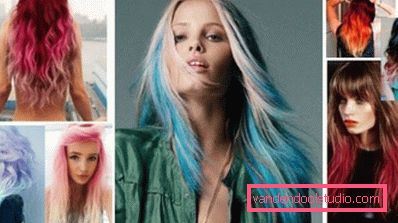
Toning called color ombre gives expressive hairstyle and will not allow its owner to go unnoticed. Recently, the coloring of ombre is quite popular among women of different ages, because it has a number of indisputable advantages.
Why ombra became popular?
- A more gentle effect on the curls (chemicals are applied not to the entire drip, but, as a rule, only on the tips);
- Frequent tinting and updating the color of the roots is not required. After all, the ombra is intended as an imitation of growing roots;
- The volume, which is obtained by lightening some strands and shading others. Instead of a one-dimensional and smooth hairstyle, a colored ombre on the hair gives the effect of a fluffy iridescent mane;
- By adjusting and shifting the border of color, you can focus on the cheekbones, lips, eyes, or divert attention from the irregular shape of the face, its flaws;
- Reasonable cost of staining in the cabin. You should always trust a professional in order not to be disappointed in the technique, making mistakes when coloring at home.
- In addition, colored ombre on long hair - a great way to demonstrate the taste and personality.
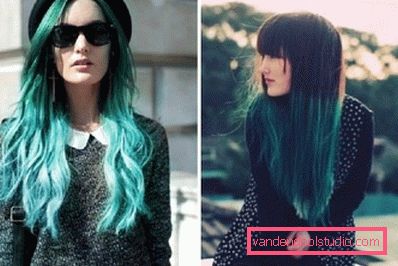
Shades on the verge of a foul: how to choose colors
The question of how to make a colored ombre is not really the most important. In the first place is the choice of color. According to most colored ombre on long hair - the choice on the cutting edge of fashion. There is no room for error. A person who dares to color ombre at home should be familiar with the most common and relevant combinations of colors.
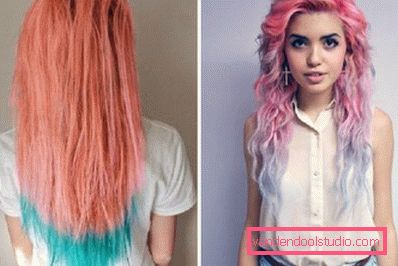
Options for light brown hair
- If we consider the colored ombre on light brown hair, then you should pay attention to the "flames". The roots are dark blond, and then there is a sharp transition to the red tips. As an option - the ends of the color of copper or molten gold.
- Fantasy shades on a dark brown suitable for romantics, creative and informal natures. Conceiving colored ombre on light brown hair, stop at shades of lavender, lilac, iris. All of them are able to create a stunning effect, especially in combination with expressive facial features.
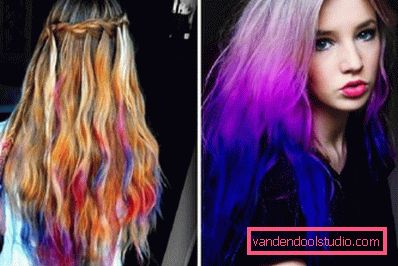
Options for brunettes
Thinking through the color ombre on dark hair, pay attention to the photos of the following combinations:
- Two very saturated colors. This can be, for example, chocolate and violet. The main condition is a clear transition line;
- Tricolor: on the base of the blue-black strands, you can make the flow of purple into red, and red - into yellow. Boldly, but the result is worth it;
- Multi-layered and colored ombra on dark hair is a win-win combination. Initially, the hair is cut in a "cascade" (then the base will be burgundy or bright red, and the tips stand out crimson);
- Delicate chocolate-purple - with the transition to the crimson at the ends. The very hair should be very dark, better than black;
- An interesting option for dark chestnut strands is partial tinting in turquoise. Traditionally, chocolate and turquoise are considered a good tandem, it is possible to try a similar colored ombre on long hair.
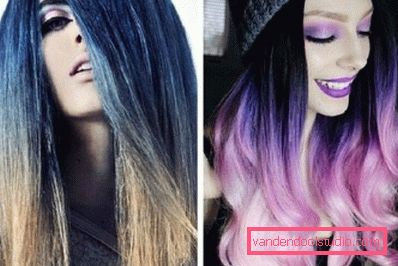
On short hair
It is believed that the color ombra for short hair is rarely successful (not enough space to make a qualitative transition from color to color). Rescues two-color coloring with a clear border (so you can draw attention to the line of the cheekbones).
- The ideal colored ombre for short hair is a contrasting dye in the most audacious colors (green, ultramarine, crimson), made on a classic square.
- Another option for ultrashort hair is to buy a special ombre brush with five steps of the length of the villi. This creates the most creative and smooth transitions that cannot be done on short strands using traditional tools and foil.
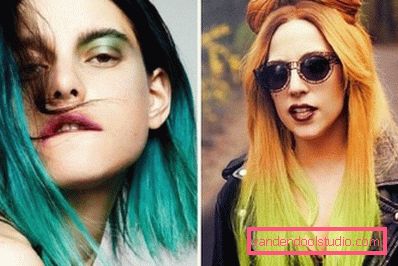
Budget option: do it yourself colored ombra
Together with supporters of reasonable economy, as well as with those who like to dye their hair on their own, we will try to find out whether it is possible to perform a colored ombre at home at a decent level.
Tools, materials
- Gloves and apron;
- Capacity for clarifier (not metal - plastic or glass is better);
- Frequent plastic comb, brush or sponge;
- Hair ties, clips, barrettes;
- Colored foil (can be replaced with cling film).
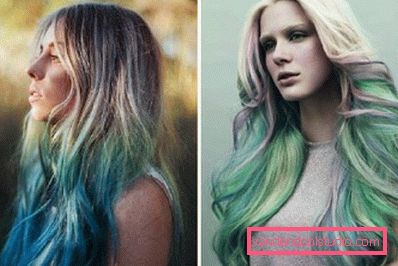
Tips for beginners
- Before the start of the transformation, it would be useful to remove the split ends of the hair. Bright colors attract increased attention to the state of hair, and even if the coloring step by step carried out without errors, the entire effect can be reduced to zero.
- Do not make an ombra on freshly washed hair. Fat on the skin and hair roots is able to protect them from the aggressive action of the dye where it is more effective than cosmetic products.
- The brightener is useful if we want to get a lasting effect on dark hair. With the original color blond or light-brown, this item can be omitted.
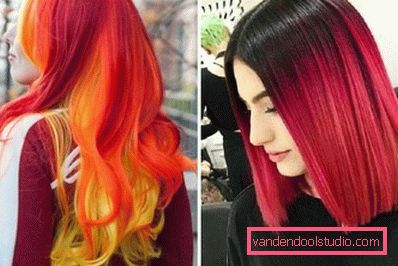
Foil: use or not
It all depends on the desired effect.
- If it is necessary to make the transition smooth and natural, the paint (brightener) is applied with a brush in stages to each strand. For the face, the border of color should shift a little higher in relation to the back of the head.
- When you need a clear color border, you can not do without foil and hairdressing gum. Compresses are applied to each strand for up to half an hour. Then you can wash out the brightener and apply the primary colors - on dry or wet strands (more precisely, the manufacturer's instructions tell us).
Short-lived but bright
- In addition to resistant paints, there are tonics that are applied to pre-bleached hair and are considered to be a more gentle counterpart to traditional cream colors.
- Toning means are easy to use; you can paint over bleached strands with your hands with gloves or a brush, adjusting the transition height and color gradient.
- An excellent, though temporary option are special dry crayons for coloring. Shadows, sprays, powder and mascara are also available. These are all quick and harmless ways to make a colored ombre on the hair itself. After all, if something goes wrong, the result is easily washed off with water - even a trace will not remain.
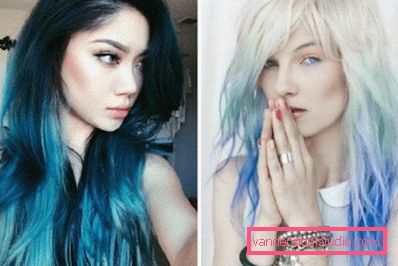
It is very difficult to achieve a good effect, trying to do the ombra staining on oneself, without any help. The fact is that the scheme of coloring the parietal and occipital parts of the head is rather complicated, and in order to correctly perform color transitions, a single mirror is not enough. Look for a reliable assistant, then the result may come close to the salon.